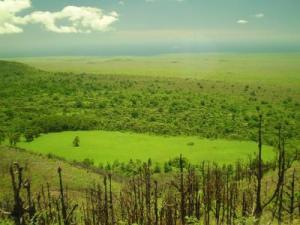Sep 5 2014
Non-native invasive plants have overrun some parts of the Galapagos Islands, finds a new study by The University of Western Australia. Mandy Trueman, a PhD researcher at UWA School of Plant Biology, has led the study and has delivered a map and a related database that provides information about native species as well as introduced species.
 This landscape was taken looking NW from the summit of Santa Cruz Island, showing some native vegetation (foreground), a patch of invasive elephant grass, native Scalesia forest invaded with several species (behind the grass patch), and invasive Avocado forest (behind grass, a dark patch on the left). Credit: Mandy Trueman
This landscape was taken looking NW from the summit of Santa Cruz Island, showing some native vegetation (foreground), a patch of invasive elephant grass, native Scalesia forest invaded with several species (behind the grass patch), and invasive Avocado forest (behind grass, a dark patch on the left). Credit: Mandy Trueman
The Galapagos National Park, which includes the Santa Cruz Island, has been known for its biodiversity. However, it has been overrun with invasive weeds in certain parts, even though National Park rangers have undertaken controlling measures.
In Santa Cruz Island’s humid highland sections, non-native grasses, vegetation and trees account for around 50% of the vegetation canopy. This invasion is threatening the native flora and fauna species in the Galapagos. Some of these species are rare and do not grow in any other part of the world.
The Ministry of Environment has made significant efforts for controlling the spread of invasive species and is also replacing them with native species. This initiative has helped recover some areas that are very important in terms of ecological value. The Galapagos National Park is producing endemic plants that are being used for reforestation efforts.
Heinke Jäger of the Charles Darwin Foundation stated that information about where the non-native plants had invaded would help conservation managers take appropriate measures.
The results of the study have been published in Neobiota, an open access journal.